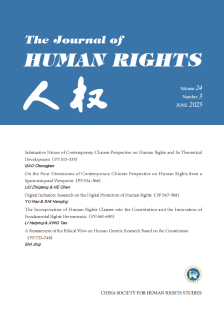
Baimachilin
Jiang Jianguo
Ma HuaideFu ZitangShen YongxiangLu Guangjin
Tang Xianwen
Wu LeifenLi Xiaojun
F-chinahrs@public.bta.net.cn



VOL. 24 NO. 3 JUNE 2025
News-Clips (2025. 06 - 2025. 07) The Conditions and Limits for the Recognition of Environmental Rights as a Constitutional Right as an Emerging Right Policy Evolution and Development Prospects of Human Rights Education from the Four Editions of the Human Rights Action Plan of China United Nations Standards and Chinese Approach for Human Rights Education in Primary and Secondary Schools